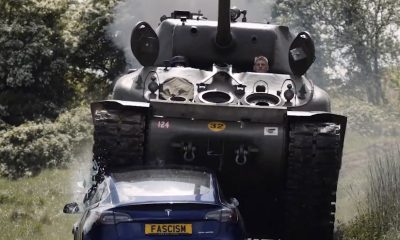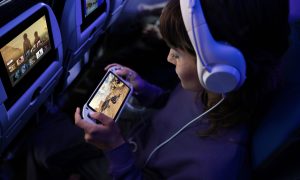Ford has announced that customers should no longer use the North American Charging Standard (NACS) adapters that it initially shipped to electric vehicle (EV) owners, now saying the hardware could cause charging speed issues.
This week, Ford issued a post on its website warning customers to avoid using the Tesla NACS adapters it previously sent to EV owners, noting that it could result in port damage and a potential reduction in charging speeds over time. The automaker says it will send customers a replacement NACS adapter in the coming weeks, along with having them return their original equipment.
Ford writes as follows on its website:
As a part of ongoing testing, your adapter has been identified by Ford to have a potential issue that may result in reduced charging speeds over time, and in some cases, charge port damage. As such, Ford does not recommend using the adapter initially supplied to you with any vehicle from this time on, and we will be sending you a replacement.
At the time of writing, Ford has not yet responded to Teslarati’s request for comment on the issue.
RELATED:
Ford EV owners were the first non-Tesla drivers to gain access to the vast Tesla Supercharger network in late February, at which point the automaker began supplying customers with the NACS adapters. Weeks following Ford, Rivian’s EVs also gained access to the Supercharger network, and General Motors (GM) has also joined in the months since.
The news also comes after Ford recently launched a free home charging program, dubbed the Power Promise program, which offers EV owners a free home charger and installation with purchases of a Mustang Mach-E, F-150 Lightning, or E-Transit.
Like many legacy automakers, Ford has had to pump the brakes on its EV strategy throughout much of this year, as sales growth has slowed for its battery-electric offerings. The company is still aiming to launch new EVs in the coming years, though it will do so slowly, scaling back on EV investments and commitments, and ultimately trying to focus on reaching profitability with its current models.
Ford is adding one of Tesla’s most unique entertainment features
What are your thoughts? Let me know at [email protected], find me on X at @zacharyvisconti, or send us tips at [email protected].
News
Grok 3 by xAI Rolls Out on Azure AI Foundry with Free Trial
Grok 3 is now on Azure AI Foundry with a free preview until early June. From code to vision, Grok joins a growing roster of powerhouse models.

xAI’s Grok 3 model is now available on Microsoft’s Azure AI Foundry Models, launching with a free preview to drive AI innovation. The collaboration marks a significant step in making advanced AI accessible to developers worldwide.
Grok 3 became available on Microsoft’s Azure AI Foundry Models on May 19, 2025. Developers can explore xAI’s Grok 3 at no cost through early June. After the free trial period, Grok 3 prices will be as follows:

“Microsoft and xAI are thrilled to unveil the availability of Grok 3 into the Azure AI Foundry Models, marking a significant milestone in AI accessibility and innovation,” Microsoft stated in its announcement.
The partnership integrates xAI’s cutting-edge model with Azure’s secure, scalable infrastructure, enabling enterprise scenarios in reasoning, coding, and visual processing. Grok 3 is accessible via Azure AI Foundry’s catalog, alongside models from OpenAI, Meta, Cohere, NVIDIA, and Hugging Face, reflecting Microsoft’s commitment to a diverse AI ecosystem.
“The addition of xAI’s Grok 3 underscores Microsoft’s commitment to support an open, diverse AI ecosystem, rather than relying on a single model provider,” the company noted.
Like other AI models in Azure, developers can easily discover and deploy Grok 3’s model card. Grok 3 is also available for testing on GitHub models.
Microsoft provides two flexible deployment options for integrating xAI’s Grok 3 into applications: Standard Pay-Go or Provisioned Throughput Units (PTUs). The Standard Pay-Go option allows pay-per-token API calls for quick scaling. Meanwhile, the PTUs are better for reserved capacity with predictable latency.
“For production scenarios where you expect steady high volume or need strict latency, provisioning Grok 3 with PTUs can be cost-effective and reliable,” Microsoft advised.
The launch of Grok 3 on Azure AI Foundry empowers developers to build intelligent assistants, process large documents, or explore new AI applications. As xAI and Microsoft combine innovation with robust tools, Grok 3’s arrival signals a new era of AI development, inviting creators to leverage its capabilities and shape the future of technology.
Elon Musk
Tesla Robotaxi deemed a total failure by media — even though it hasn’t been released
Nearly two weeks before it is even set for its planned rollout, Tesla Robotaxi has already been deemed a failure — even though it is not even publicly released.

Tesla Robotaxi is among the biggest tech developments of the year, and its June launch date has not yet arrived.
This does not matter to skeptics of the company, as they have already deemed the rollout a “failure,” “an enormous mess,” and plenty of other adjectives. No matter what, several outlets are already leaning on biased opinions and a lack of true evidence that points in any direction.
Futurism posted an article this morning claiming that Robotaxi is “already an enormous mess,” citing the opinions of Dan O’Dowd, perhaps Full Self-Driving’s biggest critic. There is no mention of any of the excitement or prosperity that would come from the opposite side of the argument.
Instead, it included that O’Dowd felt it was a failure in an 80-minute drive around Santa Barbara.
This is fair to include: Full Self-Driving is not perfect, which is why Tesla will implement safeguards like teleoperation at first. However, it’s not like it’s so awful it isn’t even remotely close. Personally, my experience with FSD was incredibly successful, responsible, and it was something I still wish I had on my car to this day. I wish the article would have included a quote from someone who is as equally passionate about FSD, just from the other side of the argument.

Credit: Tesla
There is no mention of Tesla’s most recent Vehicle Safety Report, which showed Autopilot-enabled cars are nearly 10x less likely to be involved in an accident compared to the national average. This might not be the same as Full Self-Driving, but it is still a testament to what Tesla has achieved with its driver assistance systems.
To be fair, Tesla has been a company that has missed timelines, especially when it comes to FSD. I used to roll my eyes a bit when CEO Elon Musk would say, “We’ll have Full Self-Driving finished by the end of the year,” or “We’ll have a million robotaxis on the road next year.” I was always skeptical.
However, Tesla has handled things differently this year. They’ve admitted the Robotaxi rollout will be controlled at first, including a fleet of only 10-20 Model Y vehicles. It will be private at launch, and only the lucky invited will have the opportunity to experience it in Austin in June.
It might be less than a public rollout, which of course, for people like you and me, is disappointing. But let’s be real: if Tesla launched a full-blown Robotaxi platform with no regulations or small-batch testing, there would be criticism of that, too.
Some media outlets are pointing to the recent NHTSA request for more information on how Tesla’s tech will “assess the ability of Tesla’s system to react appropriately to reduced roadway visibility conditions.” This seems more than reasonable as Robotaxi will be among the first driverless ridesharing programs in the United States.
Tesla gets new information request from NHTSA on Robotaxi rollout
It’s no more than a request for information on how things will be handled and how the tech works.
It is sad to see so many outlets already deem something that could be the next big thing as a failure, despite there being no real indication of it being that or a success. Let’s be fair and give Tesla an opportunity to meet its June target and Robotaxi some time to operate and prove to be a reliable ride-share option.
News
Tesla confirms annoying Full Self-Driving feature has been fixed
Tesla has changed one of its driver monitoring features in a request from several owners.

Tesla has confirmed that an annoying Full Self-Driving feature has been fixed.
We reported last week that several owners reported changes in the feature, and now we have confirmation that it has been revised by Tesla.
Tesla Full Self-Driving (Supervised) does not require a driver’s hands to be on the steering wheel. However, eye movements and attentiveness are tracked through a cabin-facing camera, aiming to improve safety and limit loopholes in the system.
Tesla seems to have fixed one of Full Self-Driving’s most annoying features
If the system detects that your eyes are not on the road or you are not paying attention, FSD will nudge you to get them back on the road. Too many occurrences of the driver not paying attention will result in losing access to FSD for the remainder of the drive.
However, many drivers using FSD complained that the system was too quick to alert drivers of inattentiveness. Fixing things like the HVAC temperature or even Autopilot settings on the center touchscreen would get you a nudge, which seemed unreasonably fast. Many drivers said it was a seven-second limit, but it seemed faster than this.
🚨 This is really nice to hear. Tesla said they’d fix it! pic.twitter.com/lFIZGc6PQ5 https://t.co/JE4UFAWEZz
— TESLARATI (@Teslarati) May 15, 2025
In my experience, FSD nudged me to pay attention to the road when I was adjusting the speed offset, which gives the vehicle permission to travel over the speed limit by a percentage. For example, a 10% offset in a 50 MPH zone would let the car travel 55 MPH.
The nudging seemed to be too fast and annoying, and many other Tesla drivers agreed. CEO Elon Musk had even noted that the nudge was too fast and drivers were right to be annoyed with it, especially considering that, in theory, it would be safer to adjust these settings on FSD and not while operating the car manually.
Tesla took the criticism drivers had and turned it into a much-needed and notable change that has now been confirmed by Ashok Elluswamy, Head of AI and Autopilot for the company:
Was much needed
— Ashok Elluswamy (@aelluswamy) May 16, 2025
The change seems to be initiated on vehicles with Hardware 4. It is certainly a welcome change as the nudge was just a tad sensitive and could have been much more reasonable.
The adjustment made by Tesla came just a week after owners truly started becoming more vocal about the issue.
-

 News2 weeks ago
News2 weeks agoTesla Cybertruck Range Extender gets canceled
-

 Elon Musk4 days ago
Elon Musk4 days agoTesla seems to have fixed one of Full Self-Driving’s most annoying features
-

 Lifestyle2 weeks ago
Lifestyle2 weeks agoAnti-Elon Musk group crushes Tesla Model 3 with Sherman tank–with unexpected results
-

 News2 weeks ago
News2 weeks agoStarlink to launch on United Airlines planes by May 15
-

 News1 week ago
News1 week agoTesla Semi gets new adoptee in latest sighting
-

 News2 weeks ago
News2 weeks agoTesla releases paid performance upgrade for new Model Y
-

 News2 weeks ago
News2 weeks agoTesla launches its most inexpensive trim of new Model Y
-

 News2 weeks ago
News2 weeks agoNew Tesla Model Y proves very sturdy after shocking high-speed crash





















